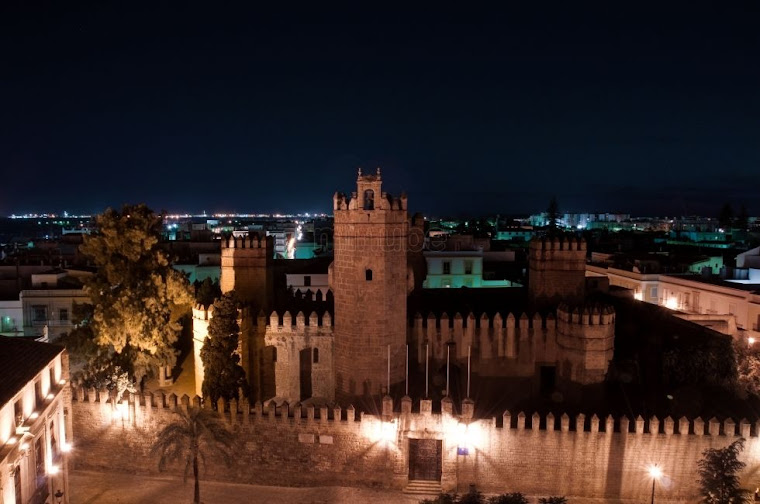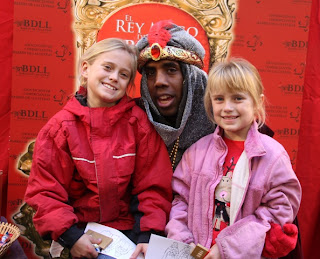Over the Christmas vacation we traveled a little through Spain with my sister Suzanne, my brother-in-law Ethan, and our two nephews, Griffin and Adrian. Andalucía is on the southern frontier with Africa, and so was the stronghold of the Moorish empire. (Andalucía is the castellanización of Al-Andalus, the Arabic name for these Iberican peninsular territories, apparently referring to the Vandals living there who invaded from the North after the fall of the Roman Empire.) These Moorish roots are most easily seen in the stunning city of Granada, an easy three and a half hour drive from our Puerto palace, as well as Córdoba, a short two-hour trip. Since Suz and Ethan had to fly from Madrid, we also decided to join them there for a quick two days. Granada—Madrid—Córdoba: that was our plan.
Granada sits up against the Spanish Sierra Nevada (not to be confused with the California ones!) This jagged mountain range rises from the mesa where Granada sits, at 738 meters (2400 feet), jutting into the sky to over 3400 meters (11,500 feet) at the highest peaks. Sierra Nevada, or “snowy saw-teeth” makes much more sense here than in California, as the contrast between the plains and this dramatic mountain chain creates a gorgeous setting for Granada, the last holdout of the Moorish invasion some 500 years ago. Boabdil, the last Emir of Granada, turned the city over to the Reyes Católicas Ferdinand II and Isabella I, in 1492. (1492 was a banner year: discovery of the New World, final reconquest of the Iberian peninsula, and expulsion of the Jews—a big mistake for the Empire. A short history here: http://www.jewishvirtuallibrary.org/jsource/Judaism/expulsion.html )
Granada’s old city has two spectacular parts that we saw: the Albaicín, made up of a maze of tiny narrow streets winding from the hilltops down to the confluence of three rivers; and the Alhambra, the stunning Moorish citadel and palaces perched on the cliffs overlooking the rivers. While we have not had the chance to travel to Morocco (and Todd probably never will, given that the Navy will not approve travel to Africa for active duty guys like him), Granada has the feel of Definitely-Not-Spain, or at least not the Spain where we have been living in for the past six months! Crowded shops spill their wares into the street, including belly-dancing costumes, wooden scimitars, bangle-laden headbands, and huge hooka pipes. Arab pastries and teashops scent the air, and we had one of the best donar kebab sandwiches at the highly-recommended Kebab King #2.
We traipsed down through the Albaicín and up the other side to the entrance of the Alhambra. This rambling collection of palaces, gardens, and fortress walls is so famous that you must make reservations to visit in advance, no matter the time of year. Once inside, you MUST adhere to your reservation times to see the Nasrid Palaces, the most intricate and oldest of the buildings, completed during the 14th century. The stonework detail, even at heights that are nearly impossible to see, was achingly beautiful. We only had a scant two days in this exotic city, making a return trip mandatory, to the Alhambra as well.
Next stop: Madrid. More than anything, Madrid struck me as a Spanish-style NYC, but more beautiful: huge, bustling, crowded, elegant, with Metro, tall buildings, gorgeously planned plazas and parks, and sprawling suburbs. Again, we spent a mere two days in this busy capital, having rented an apartment next to the Plaza España. A virus slowed us down—nearly everyone had been run over by a nasty throat-and-sinus bug earlier that week, and Suz was its current victim—so we kept an easy pace and braved the Reyes Magos crowds for just a few hours the first evening.
The streets were packed with last-minute shoppers—on January 4th!—for the coming of the Three Wise Men who would FINALLY bring presents to all the Spanish kids. There were performance artists everywhere: a man covered in black metallic paint, posing as a statue of a coal miner; a huge action-figure-Satan-Lucifer-creature, complete with sword that he obligingly put to the necks of tourists posing for a picture with him; a refrigerator box with three wild-haired heads popping out of it which would shriek at you if you walked too close, much to the amusement of the onlookers.
The next day we visited the open spaces of Madrid, heading up to the Parque de Retiro to row around in the lake’s little boats. Instead of boats, the kids chose to have a massive bird-feeding session after running around through several of the park’s wonderful playgrounds. Taking the Metro home (underground and efficient), we had an Argentine dinner with madrileño Angel, a friend of Ethan’s, and called it a night.
 |
| Todd as Madrileño en el Parque de Retiro |
On to Córdoba! Our way home led past this World Heritage Moorish city, capital of the independent Emirate of al-Andalus in the 10th and 11th century. Back then it was estimated to be the largest city in Europe and its intellectual center, with some 500,000 inhabitants! Now, however, it has an intimate, comfortable feel; the winding streets of the Jewish quarter, the Roman bridge, and the breathtaking Mezquita were all easily within walking distance. Rocio, our host at Hotel Don Paula, a converted-family-home-hotel, gave us great advice on what to see and where to go during our short day-and-a-half here. By far my favorite was the Mezquita, or Cathedral and former Great Mosque of Córdoba. The complex is enormous, given Córdoba’s relatively small size. Built over two centuries, from 784 to 987, the mosque was reinvented with Catholic chapels after the Reconquista, and Carlos V built a whole Renaissance cathedral right in the middle! (Such is its size that you don’t even realize this upon entering the Mezquita’s grounds.) Absolutely worth a return visit.
Less entertaining although riveting (for me, anyway) was the Museo de la Inquisición. Todd refused to even go in, saying there was enough bad in the world without paying to see it. Tia and Sasha were fascinated by the suits of armor and other war gear, and I was in the middle of reading about the Inquisition in my book, Civilización y cultura de España. Five minutes into it, after seeing the cage with the head shackles, the metal masks with no mouths (the better to gag you with), the Catherine Wheel (with a lovely picture of a woman bound to it with a fire underneath) and the (mildly amusing) barrel that drunkards had to wear as penitence, Tia and Sasha had had enough. Each exhibit had an explanation; most of the devices were invented outside of Spain. Creepily fascinating but not worth going back to!



















